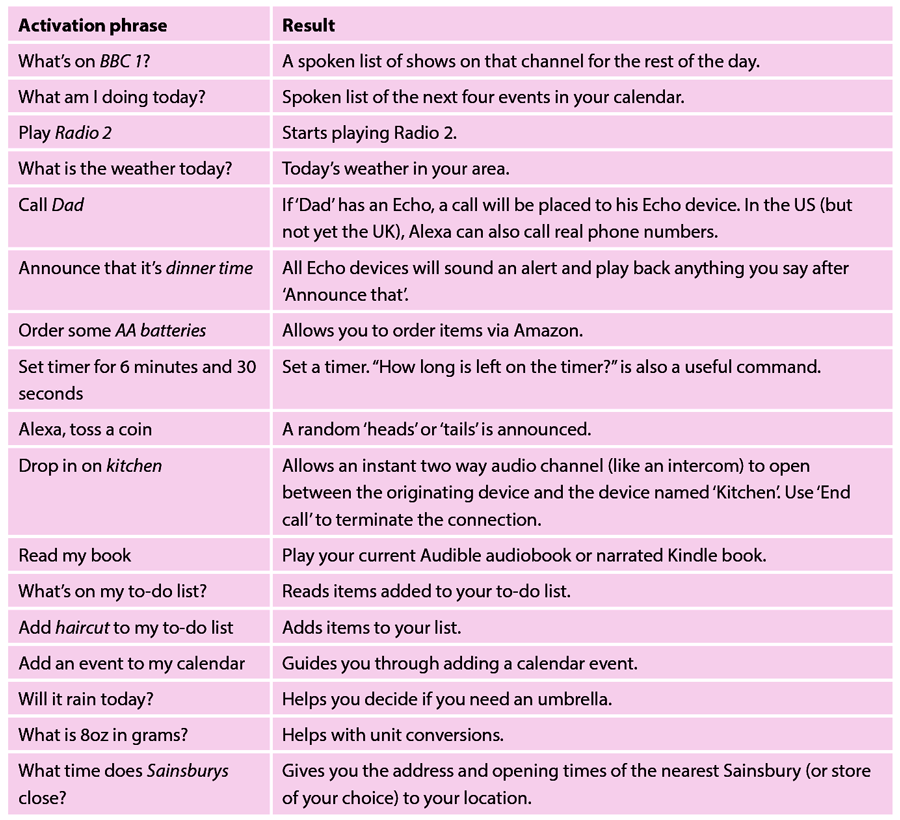Many readers will have experience of using smart speakers, such as the Amazon Echo or the Google Home. These popular devices are inexpensive and powerful. In brief, smart speakers listen for a spoken trigger word, followed by verbal commands. Commands can be simple, such as, “Alexa, what time is it?” or more complex, like, “Alexa, wake me up every day at 8am with Radio 4”.
Without a doubt these devices are a fun and modern convenience. They are also proving remarkably popular with the sight impaired. In this issue we will cover the basics of the leading devices and share some of the ways they are useful to the sighted and sight impaired.
What devices are available?
The market leader is Amazon, with a wide range of Echo devices. The most popular is the inexpensive Echo Dot. This is £50 per device, and is frequently discounted on Amazon. The Google Home is also a popular home speaker, also with a £50 basic device, called the Google Home Mini. Apple make a smart speaker, but it has fewer capabilities and is over £300 at this time. The Amazon devices are the most popular and also the most versatile. The rest of this article will focus on the capabilities and uses of Alexa, the voice assistant integrated into the Echo devices. All of the voice capabilities are available regardless of the model that is purchased. The only real difference between the £50 Echo Dot, the £90 Echo and the £140 Echo Plus is the size and quality of the integrated speaker. This makes the Echo Dot, often priced under £40, an ideal smart speaker to explore this type of technology.
Requirements and set-up
Other than the device itself, a smartphone or tablet is required, along with an internet connection and WiFi access. Configuration and set-up is performed by the Alexa app (Android and iOS). Although much can be achieved with one Echo device, adding additional units widens the range of possibilities. The addition of paid services also improves the capabilities. One example that needs multiple devices and a paid service is multi-room audio. In a house with four Echo devices, one can say “Alexa, play some Beethoven upstairs”. If the Echo devices are grouped according to their location, the upstairs devices will then simultaneous play music of your choosing. A service, like Spotify or Amazon Prime, is required for a wide range of music.
Basic commands
The list below gives some examples of popular commands. They are built-in features and require little, or no, configuration to enable. All requests need to be prefixed with the ‘wake’ word. By default this is ‘Alexa’ but can be changed to a few others. Many of these commands make the lives of sight impaired individuals much easier. For instance, having a spoken TV guide can be very helpful if acuity is too poor to read.
Skills
Much like smartphones, the Echo devices can be made more capable by the addition of apps (or skills) written by third parties. These extra skills give the Alexa platform its versatility, allowing a wide range of features to be added. Again, like apps, there is a catalogue of ‘skills’ that can be searched and subsequently enabled.
Here are some example skills:
My Talking Newspaper – Allows a user to find and listen to a local talking newspaper.
Morrisons Skill – Allows users to add Morrisons groceries to a list and have them delivered.
Uber – Enables: “Alexa, ask Uber to request a ride.”
Storytime – Enables: “Alexa, ask Amazon Storytime to read me a story.”
National Rail – Enables: “Alexa, plan a journey.”
Fitbit – Enables: “Alexa, ask Fitbit how I’m doing today.”
Smart home devices
If other smart home devices are on the WiFi network, Echo devices can usually be configured to control them. The Amazon Fire TV device is particularly useful for those with sight impairment. Alexa can be asked to change channel or to play the latest episode of a particular show. Other common devices that can be controlled are smart thermostats, light bulbs, smart power sockets and even microwaves.
Routines
Alexa Routines allows a simple command to trigger several events. For instance, you could make “Alexa, good morning” trigger a sequence of tasks. For example, turn on the lights, turn on a favourite radio station and switch on your coffee machine. A ‘leaving the house’ or ‘going away on holiday’ routine could similarly be created.
The author has no proprietary or financial interests in the products discussed.
COMMENTS ARE WELCOME






